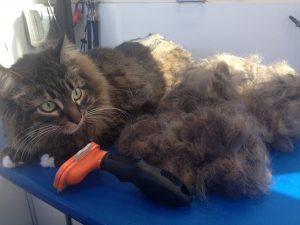How to Reduce Cat Hairballs
Hairballs can be a real problem, but are probably more of a problem than most cat parents realize. In fact, the technical name for them, trichobezoars, sounds a bit less benign than the word “hairball” and gives a better idea of seriousness of the problem. “Tricho” means pertaining to hair, while “bezoar” means a mass trapped in the gastrointestinal system, so a hairball is a mass of hair trapped in the intestinal system. Sounds pretty uncomfortable, doesn’t it?
 How Hairballs Form
How Hairballs Form
Cats have a rough tongue comprised of backward facing barbs. It serves them well in removing external parasites, dirt, and debris from their coats. It also helps them remove dead and loose fur. Unfortunately, once the fur is on the tongue, the only way to get rid of it is to swallow it. Some of the fur makes it all the way through the digestive track while some remains in the stomach where it becomes entangled with more and more fur.
Once formed, if the hair ball cannot be eliminated the cat may vomit it up. As unpleasant as it may be to have to clean them up, it is far better for the cat to expel the hair ball than for it to remain in their system and cause an intestinal blockage, which can be quite serious. If the hair becomes lodged, it blocks digested food from passing through and causes an impaction which could require surgery.
Best Ways to Reduce Hairballs
If your cat is prone to getting hairballs, there are a few things you can do that have proven most helpful in preventing their formation:
-
Consider giving your cat an Omega 3 supplement. This will help maintain the condition of the skin and coat which reduces shedding.
-
Switch to foods formulated to reduce hairballs.
-
Give your cat hairball lubricant. Talk to your vet about the best brands and solutions.
-
If your cat excessively grooms, provide toys for distraction.
-
Brush your cat regularly.
-
Get the cat groomed and professionally de-shed regularly.
 Professional Grooming
Professional Grooming
Regular and professional pet grooming is very helpful in reducing your cat’s problem with hair balls. Regular de-shedding can help remove dead and loose fur that would otherwise end up in their digestive system. De-shedding is a process that, while gentle, aggressively removes dead and loose fur from cat’s coat. De-shedding tools reach past the top layer and address densely-furred coats and combination coats.
An additional option is to give longer haired cats a trim so that less fur makes it to the digestive system.
If your cat has problem hairballs and seems listless or is having problem eating, be sure to take them to the vet to rule out impaction. If you do not know a great vet, feel free to contact us. We are always happy to share our customer referrals!
